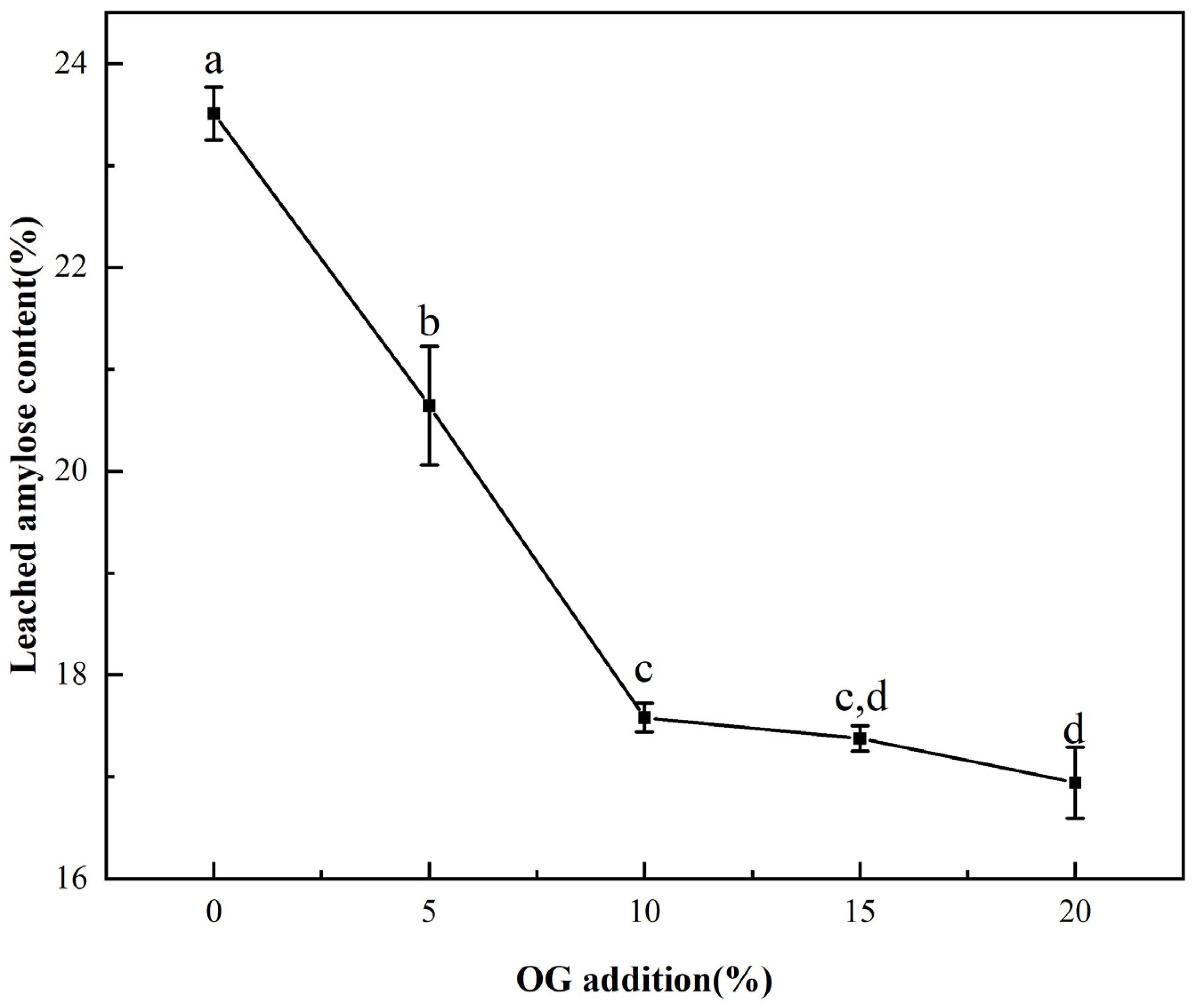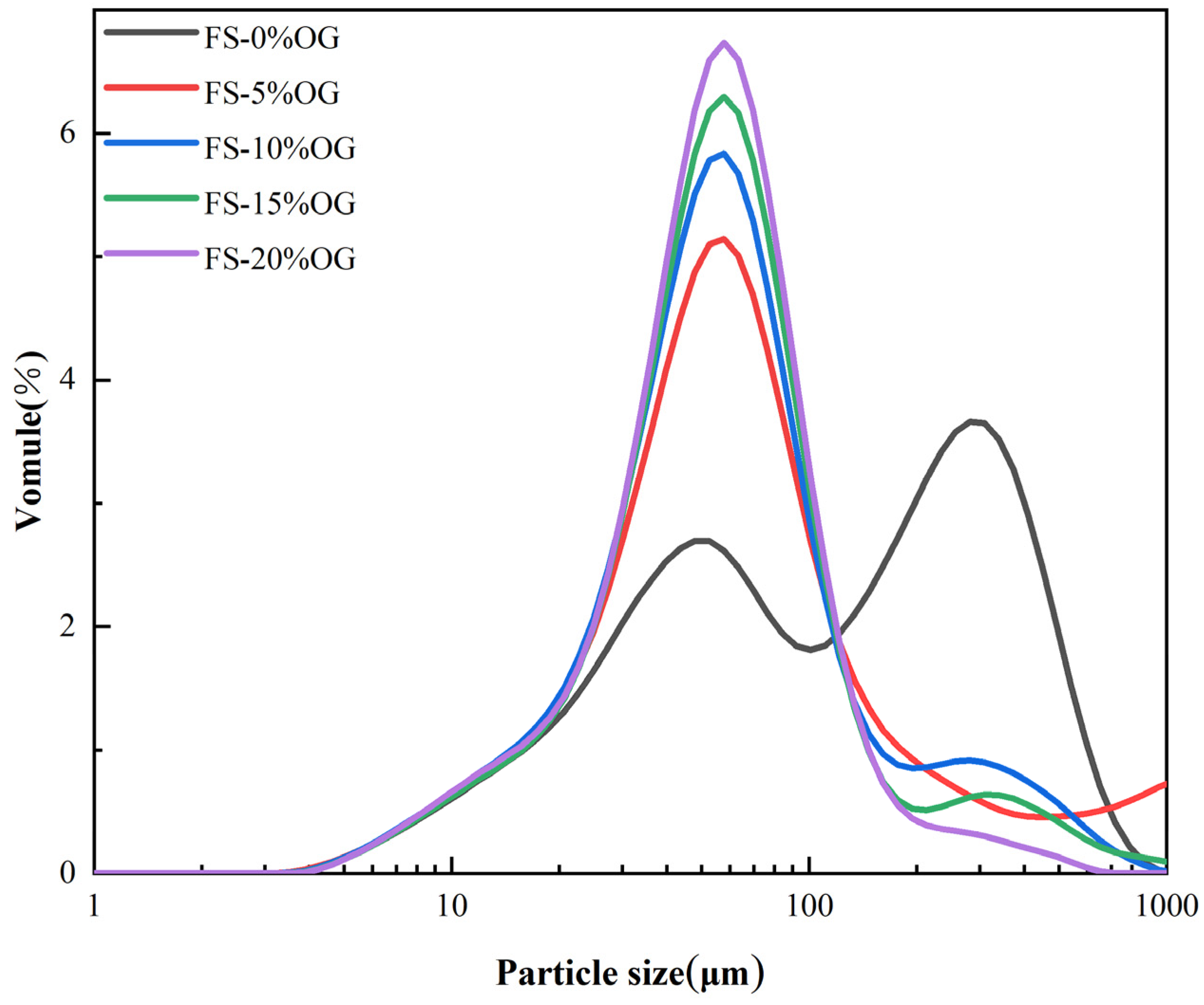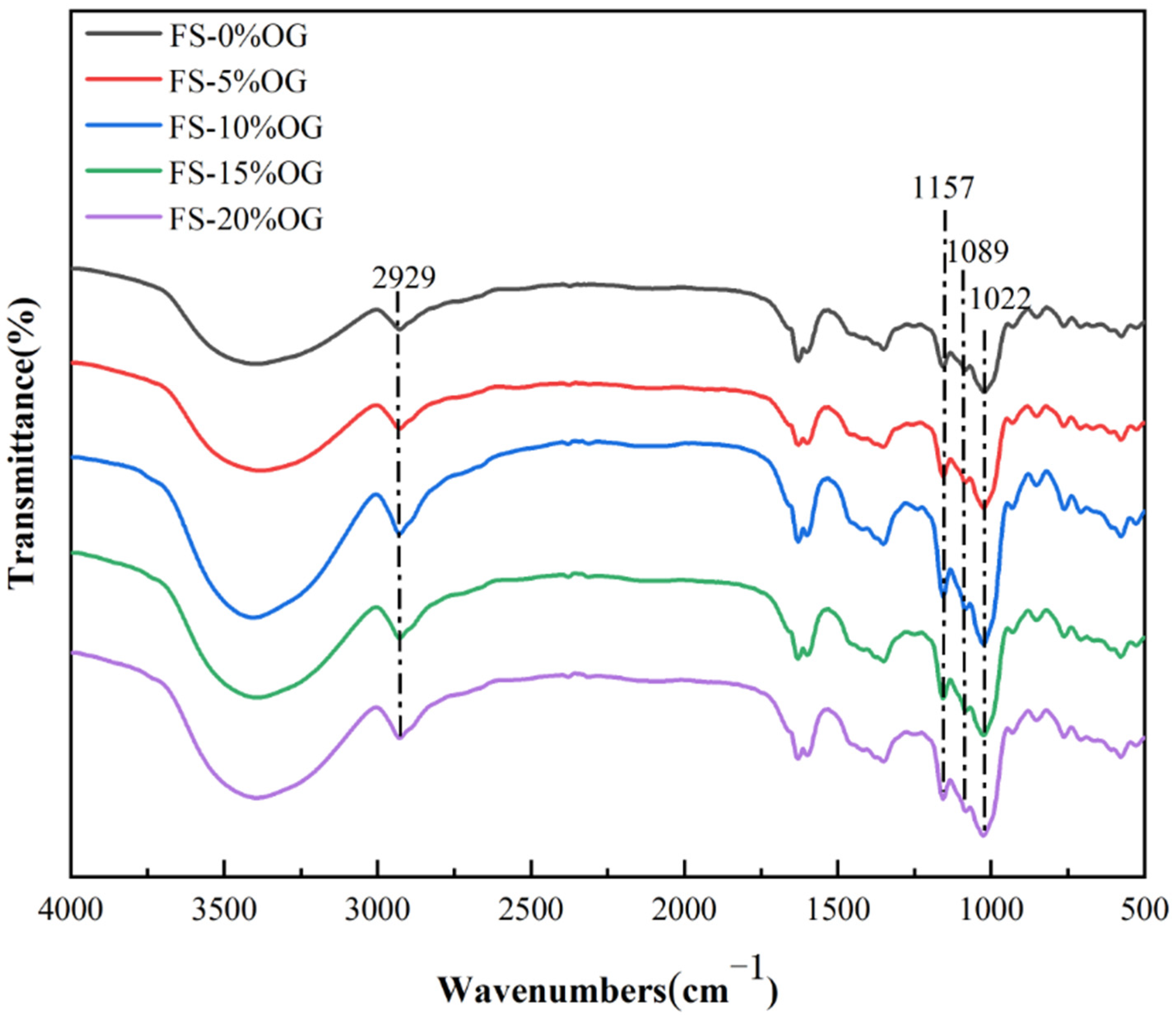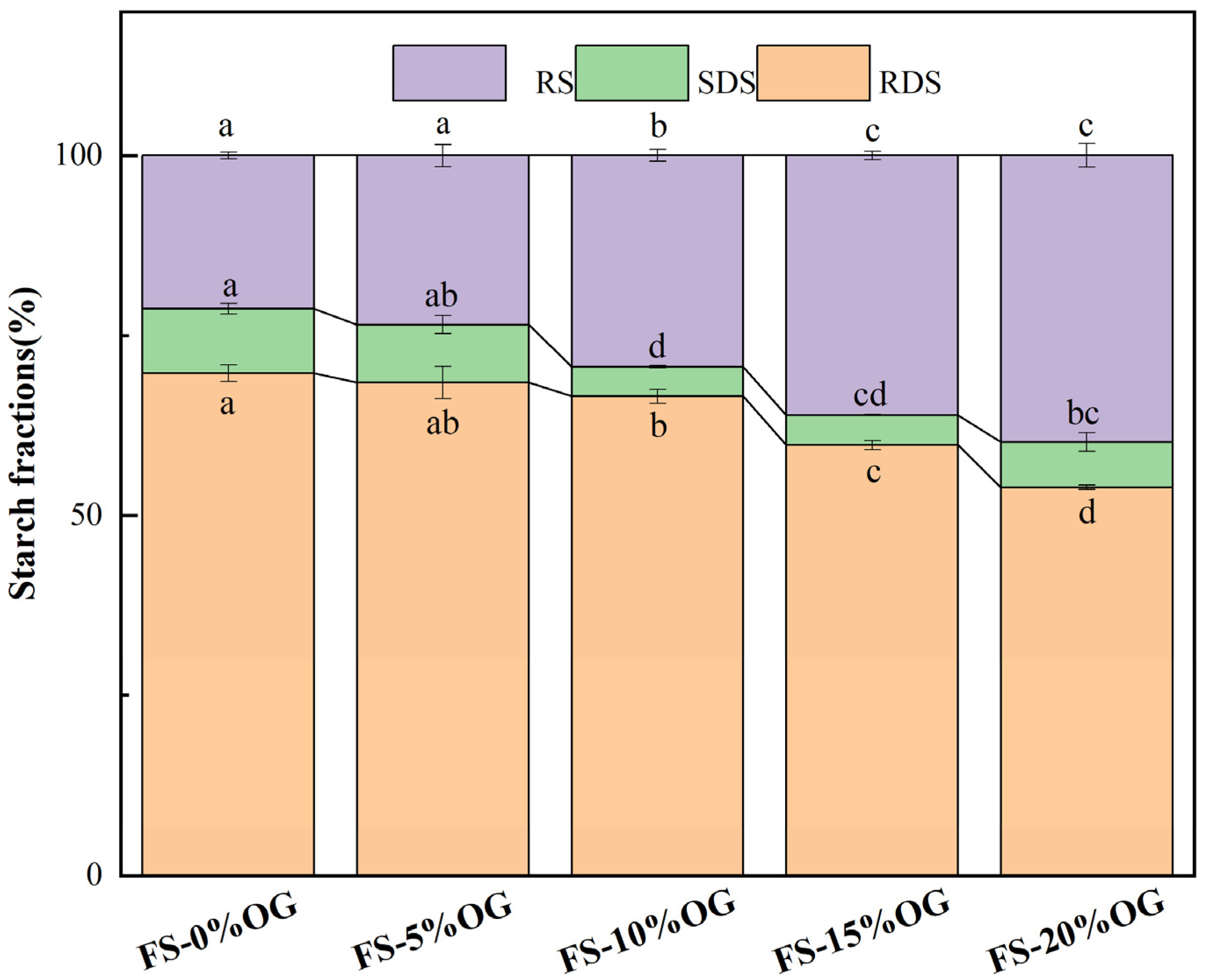Effect of Oat Beta-Glucan on Physicochemical Properties and Digestibility of Fava Bean Starch
Abstract
1. Introduction
2. Materials and Methods
2.1. Materials
2.2. FS-OG System Preparation
2.3. Pasting Properties
2.4. Extraction of Amylose Content Determination Process
2.5. Particle Size Distribution
2.6. Dynamic Rheological Properties
2.7. Textural Properties
2.8. X-ray Diffraction (XRD)
2.9. Fourier Transform-Infrared Spectroscopy (FT-IR)
2.10. Scanning Electron Microscopy (SEM)
2.11. In Vitro Digestion
2.12. Statistical Analysis
3. Results and Discussion
3.1. Pasting Properties
3.2. Leached Amylose Content
3.3. Particle Size Distribution
3.4. Dynamic Rheology Properties
3.5. Textural Properties
3.6. XRD
3.7. FT-IR
3.8. SEM
3.9. In Vitro Digestibility
4. Conclusions
Author Contributions
Funding
Institutional Review Board Statement
Informed Consent Statement
Data Availability Statement
Conflicts of Interest
References
- Ren, Y.; Yuan, T.; Chigwedere, C.; Ai, Y. A current review of structure, functional properties, and industrial applications of pulse starches for value-added utilization. Compr. Rev. Food. Sci. F. 2021, 20, 3061–3092. [Google Scholar] [CrossRef] [PubMed]
- Hiromi, Y.; Masayuki, S.; Naoko, Y.; Yuka, T.; Yoshiyuki, M. Fatty acid distribution in triacylglycerols and phospholipids of broad beans (Vicia faba). Food Chem. 2008, 112, 924–928. [Google Scholar]
- Zhao, W.; Liang, W.; Ospankulova, G.; Muratkhan, M.; Kh, K.; Li, W. Electron beam irradiation modification of ultra-high pressure treated broad bean starch: Improvement of multi-scale structure and functional properties. Food Chem. 2023, 427, 136690. [Google Scholar] [CrossRef] [PubMed]
- Nilsson, K.; Johansson, M.; Sandström, C.; Röhnisch, H.; Hedenqvist, M.; Langton, M. Pasting and gelation of faba bean starch-protein mixtures. Food Hydrocoll. 2023, 138, 108494. [Google Scholar] [CrossRef]
- Sofi, B.; Wani, I.; Masoodi, F.; Saba, I.; Muzaffar, S. Effect of gamma irradiation on physicochemical properties of broad bean (Vicia faba L.) starch. LWT-Food. Sci. Technol. 2013, 54, 63–72. [Google Scholar] [CrossRef]
- Piecyk, M.; Domian, K. Effects of heat–moisture treatment conditions on the physicochemical properties and digestibility of field bean starch (Vicia faba var. minor). Int. J. Biol. Macromol. 2021, 182, 425–433. [Google Scholar] [CrossRef] [PubMed]
- Johansson, L.; Virkki, L.; Maunu, S.; Lehto, M.; Ekholm, P.; Varo, P. Structural characterization of water soluble β-glucan of oat bran. Carbohydr. Polym. 2000, 2, 143–148. [Google Scholar] [CrossRef]
- Krawęcka, A.; Sobota, A.; Sykut-Domańska, E. Physicochemical, sensory, and cooking qualities of pasta enriched with oat β-glucans, xanthan gum, and vital gluten. Foods 2020, 9, 1412. [Google Scholar] [CrossRef]
- Vasquez-Orejarena, E.; Simons, C.; Litchfield, J.; Alvarez, V. Functional properties of a high protein beverage stabilized with oat-β-glucan. J. Food Sci. 2018, 83, 1360–1365. [Google Scholar] [CrossRef]
- Buniowska, M.; Mykhalevych, A.; Polishchuk, G.; Sapiga, V.; Znamirowska-Piotrowska, A.; Kot, A.; Kamińska-Dwórznicka, A. study of water freezing in low-fat milky ice cream with oat β-glucan and its influence on quality indicators. Molecules 2023, 28, 2924. [Google Scholar] [CrossRef]
- Jaimee, H.; Sara, G. Oat and Barley in the Food Supply and Use of Beta Glucan Health Claims. Nutrients 2021, 13, 2556. [Google Scholar] [CrossRef] [PubMed]
- Cui, Y.; Han, X.; Huang, H.; Xie, W.; Zhang, X.; Zhang, Z.; Yu, Q.; Lu, T.; Li, T.; Li, S. Effects of different sources of β-glucan on pasting, gelation, and digestive properties of pea starch. Food Hydrocoll. 2022, 135, 108172. [Google Scholar] [CrossRef]
- Li, S.; Zhang, M.; Ren, X.; Guan, L.; Mi, Y.; Ye, G. Effects of oat β-glucan on the retrogradation behavior of rice starch and its potential mechanism. Int. J. Biol. Macromol. 2024, 260, 129509. [Google Scholar] [CrossRef]
- Zhou, D.; Zhang, B.; Chen, B.; Chen, H. Effects of oligosaccharides on pasting, thermal and rheological properties of sweet potato starch. Food Chem. 2017, 230, 516–523. [Google Scholar] [CrossRef]
- Liu, D.; Li, Z.; Fan, Z.; Zhang, X.; Zhong, G. Effect of soybean soluble polysaccharide on the pasting, gels, and rheological properties of kudzu and lotus starches. Food Hydrocoll. 2019, 89, 443–452. [Google Scholar] [CrossRef]
- Kong, X.; Zhu, Z.; Zhang, X.; Zhu, Y. Effects of cordyceps polysaccharides on pasting properties and in vitro starch digestibility of wheat starch. Food Hydrocoll. 2020, 102, 105604. [Google Scholar] [CrossRef]
- Feng, T.; Shui, M.; Chen, Z.; Zhuang, H.; Wang, W.; Yang, Y.; Zhang, J.; Ye, R. Hericium Erinaceus β-glucan modulates in vitro wheat starch digestibility. Food Hydrocoll. 2019, 96, 424–432. [Google Scholar] [CrossRef]
- Yan, Y.; Peng, B.; Niu, B.; Ji, X.; He, Y.; Shi, M. Understanding the structure, thermal, pasting, and rheological properties of potato and pea starches affected by annealing using plasma-activated water. Front. Nutr. 2022, 9, 842662. [Google Scholar] [CrossRef] [PubMed]
- Cheng, W.; Sun, Y.; Xia, X.; Yang, L.; Fan, M.; Li, Y.; Wang, L.; Qian, H. Effects of β-amylase treatment conditions on the gelatinization and retrogradation characteristics of wheat starch. Food Hydrocoll. 2021, 124, 107286. [Google Scholar] [CrossRef]
- Liu, C.; Zhang, H.; Chen, R.; Chen, J.; Liu, X.; Luo, L.; Chen, T. Effects of creeping fig seed polysaccharide on pasting, rheological, textural properties and in vitro digestibility of potato starch. Food Hydrocoll. 2021, 118, 106810. [Google Scholar] [CrossRef]
- Wang, S.; Wang, J. Annealing improves paste viscosity and stability of starch. Food Hydrocoll. 2017, 62, 203–211. [Google Scholar] [CrossRef]
- Kong, J.; Mo, S.; Hu, J.; Shen, M.; Yu, Q.; Chen, Y.; Xie, J. Effects of Ficus pumila Linn. polysaccharide on physicochemical and digestive properties of corn starch. Food Biosci. 2024, 58, 103811. [Google Scholar] [CrossRef]
- Ji, X.; Chen, J.; Jin, X.; Chen, J.; Ding, Y.; Shi, M.; Guo, X.; Yan, Y. Effect of Inulin on Thermal Properties, Pasting, Rheology, and In Vitro Digestion of Potato Starch. Starch-Stärke 2023, 75, 7–8. [Google Scholar] [CrossRef]
- Chen, L.; Ren, F.; Zhang, Z.; Tong, Q.; Rashed, M. Effect of pullulan on the short-term and long-term retrogradation of rice starch. Carbohydr. Polym. 2014, 11, 415–421. [Google Scholar] [CrossRef] [PubMed]
- Zaidul, I.; Yamauchi, H.; Kim, S.; Hashimoto, N.; Noda, T. RVA study of mixtures of wheat flour and potato starches with different phosphorus contents. Food Chem. 2007, 102, 1105–1111. [Google Scholar] [CrossRef]
- Ren, Y.; Lian, J.; Wang, W.; Xiao, Y.; Liu, S.; Luo, Y.; Shen, M.; Xie, M. Effects of Mesona chinensis Benth polysaccharide on physicochemical and rheological properties of sweet potato starch and its interactions. Food Hydrocoll. 2020, 99, 105371. [Google Scholar] [CrossRef]
- Zhang, B.; Bai, B.; Pan, Y.; Li, X.; Cheng, J.; Chen, H. Effects of pectin with different molecular weight on gelatinization behavior, textural properties, retrogradation and in vitro digestibility of corn starch. Food Chem. 2018, 264, 58–63. [Google Scholar] [CrossRef] [PubMed]
- Wang, R.; Wan, J.; Liu, C.; Xue, X.; Ding, Y. Pasting, thermal, and rheological properties of rice starch partially replaced by inulin with different degrees of polymerization. Food Hydrocoll. 2019, 92, 228–232. [Google Scholar] [CrossRef]
- Kuang, Q.; Xu, J.; Liang, Y.; Xie, F.; Tian, F.; Zhou, S.; Liu, X. Lamellar structure change of waxy corn starch during gelatinization by time-resolved synchrotron SAXS. Food Hydrocoll. 2017, 62, 43–48. [Google Scholar] [CrossRef]
- Funami, T.; Kataoka, Y.; Omoto, T.; Goto, Y.; Asai, I.; Nishinari, K. Effects of non-ionic polysaccharides on the gelatinization and retrogradation behavior of wheat starch. Food Hydrocoll. 2005, 19, 1–13. [Google Scholar] [CrossRef]
- Sheng, L.; Li, P.; Wu, H.; Liu, Y.; Han, K.; Gouda, M.; Tong, Q.; Ma, M.; Jin, Y. Tapioca starch-pullulan interaction during gelation and retrogradation. LWT-Food. Sci. Technol. 2018, 96, 432–438. [Google Scholar] [CrossRef]
- Zhang, S.; Yue, M.; Yu, X.; Wang, S.; Zhang, J.; Wang, C.; Ma, C. Interaction between potato starch and barley β-glucan and its influence on starch pasting and gelling properties. Int. J. Biol. Macromol. 2023, 253, 126840. [Google Scholar] [CrossRef] [PubMed]
- Ranathunga, A.; Suwannaporn, P.; Kiatponglarp, W.; Wansuksri, R.; Sagis, L. Molecular structure and linear-non linear rheology relation of rice starch during milky, dough, and mature stages. Carbohydr. Polym. 2023, 312, 120812. [Google Scholar] [CrossRef] [PubMed]
- Chen, J.; Cui, Y.; Shi, W.; Ma, Y.; Zhang, S. The interaction between wheat starch and pectin with different esterification degree and its influence on the properties of wheat starch-pectin gel. Food Hydrocoll. 2023, 145, 109062. [Google Scholar] [CrossRef]
- Ji, X.; Yin, M.; Hao, L.; Shi, M.; Liu, H.; Liu, Y. Effect of inulin on pasting, thermal, rheological properties and in vitro digestibility of pea starch gel. Int. J. Biol. Macromol. 2021, 193, 1669–1675. [Google Scholar] [CrossRef] [PubMed]
- Charoenrein, S.; Tatirat, O.; Rengsutthi, K.; Thongngam, M. Effect of konjac glucomannan on syneresis, textural properties and the microstructure of frozen rice starch gels. Carbohydr. Polym. 2011, 83, 291–296. [Google Scholar] [CrossRef]
- Buleon, A.; Colonna, P.; Planchot, V.; Ball, S. Starch granules: Structure and biosynthesis. Int. J. Biol. Macromol. 1998, 23, 85–112. [Google Scholar] [CrossRef] [PubMed]
- Nilsson, K.; Sandström, C.; Özeren, H.; Vilaplana, F.; Hedenqvist, M.; Langton, M. Physiochemical and thermal characterisation of faba bean starch. J. Food Meas. Charact. 2022, 16, 4470–4485. [Google Scholar] [CrossRef]
- Ma, S.; Zhu, P.; Wang, M. Effects of konjac glucomannan on pasting and rheological properties of corn starch. Food Hydrocoll. 2019, 89, 234–240. [Google Scholar] [CrossRef]
- Zhou, J.; Jia, Z.; Wang, M.; Wang, Q.; Barba, F.; Wan, B.; Wang, X.; Fu, Y. Effects of Laminaria japonica polysaccharides on gelatinization properties and long-term retrogradation of wheat starch. Food Hydrocoll. 2022, 133, 107908. [Google Scholar] [CrossRef]
- Rong, L.; Shen, M.; Hua, W.; Xiao, W.; Li, J.; Xie, M. Effects of xanthan, guar and Mesona chinensis Benth gums on the pasting, rheological, texture properties and microstructure of pea starch gels. Food Hydrocoll. 2021, 125, 107391. [Google Scholar] [CrossRef]
- Lu, H.; Ma, R.; Chang, R.; Tian, C. Evaluation of starch retrogradation by infrared spectroscopy. Food Hydrocoll. 2021, 120, 106975. [Google Scholar] [CrossRef]
- Tu, J.; Adhikari, B.; Brennan, M.; Cheng, P.; Bai, W.; Brennan, C. Interactions between sorghum starch and mushroom polysaccharides and their effects on starch gelatinization and digestion. Food Hydrocoll. 2023, 139, 108504. [Google Scholar] [CrossRef]
- Zheng, J.; Huang, S.; Zhao, R.; Wang, N.; Kan, J.; Zhang, F. Effect of four viscous soluble dietary fibers on the physicochemical, structural properties, and in vitro digestibility of rice starch: A comparison study. Food Chem. 2021, 362, 130181. [Google Scholar] [CrossRef] [PubMed]
- Yang, F.; Miao, Q.; Zhang, X.; Xu, W.; Jia, D. Interaction between potato starch and Tremella fuciformis polysaccharide. Food Hydrocoll. 2022, 127, 107509. [Google Scholar] [CrossRef]
- Luo, Y.; Xiao, Y.; Shen, M.; Hua, W.; Ren, Y.; Yang, J.; Han, X.; Xie, M. Effect of Mesona chinensis polysaccharide on the retrogradation properties of maize and waxy maize starches during storage. Food Hydrocoll. 2020, 101, 105538. [Google Scholar] [CrossRef]
- Li, S.; Chen, W.; Abel, W.; Chen, Y.; Liang, H.; Li, J.; Li, B. Effects of non-starch polysaccharide on starch gelatinization and digestibility: A review. Food Innov. Adv. 2023, 2, 302–312. [Google Scholar] [CrossRef]
- Nguyen, T.; Flanagan, B.; Tao, K.; Ni, D.; Gidley, M.; Fox, G.; Gilbert, R. Effect of processing on the solubility and molecular size of oat β-glucan and consequences for starch digestibility of oat-fortified noodles. Food Chem. 2022, 372, 131291. [Google Scholar] [CrossRef]
- Regand, A.; Chowdhury, Z.; Tosh, S.; Wolever, T.; Wood, P. The molecular weight, solubility and viscosity of oat beta-glucan affect human glycemic response by modifying starch digestibility. Food Chem. 2011, 129, 297–304. [Google Scholar] [CrossRef]








| Samples | PV (mPa·s) | TV (mPa·s) | BD (mPa·s) | FV (mPa·s) | SB (mPa·s) | PT (°C) |
|---|---|---|---|---|---|---|
| FS-0%OG | 7043 ± 35.16 a | 4147 ± 18.23 a | 2875 ± 39.40 a | 9156 ± 148.37 a | 4988 ± 137.15 a | 72.33 ± 0.06 c |
| FS-5%OG | 4901 ± 55.19 b | 3447 ± 24.88 b | 1454 ± 31.63 b | 7048 ± 106.55 b | 3601 ± 82.29 b | 73.10 ± 0.05 c |
| FS-10%OG | 3438 ± 19.09 c | 2835 ± 2.12 c | 603.0 ± 21.21 c | 5168 ± 23.33 c | 2333 ± 25.46 c | 74.35 ± 0.50 b |
| FS-15%OG | 2442 ± 17.68 d | 2425 ± 14.85 d | 17.00 ± 2.83 d | 3695 ± 11.31 d | 1269 ± 3.64 d | 75.15 ± 0.57 a |
| FS-20%OG | 1748 ± 30.41 e | 1731 ± 29.00 e | 17.00 ± 1.41 d | 2593 ± 47.38 e | 862.0 ± 18.38 e | 75.53 ± 0.04 a |
| Sample | D(4,3) (μm) | D10 (μm) | D50 (μm) | D90 (μm) |
|---|---|---|---|---|
| FS-0%OG | 181.50 ± 3.37 b | 21.60 ± 0.14 a | 122.69 ± 2.12 a | 427.25 ± 8.13 b |
| FS-5%OG | 196.01 ± 11.77 a | 20.84 ± 0.14 c | 63.04 ± 0.46 b | 528.14 ± 5.59 a |
| FS-10%OG | 93.57 ± 0.98 c | 20.53 ± 0.04 d | 58.56 ± 0.09 c | 206.90 ± 3.20 c |
| FS-15%OG | 89.65 ± 2.04 c | 21.44 ± 0.03 b | 58.24 ± 0.09 c | 149.32 ± 2.46 d |
| FS-20%OG | 69.04 ± 0.07 d | 20.86 ± 0.03 c | 56.61 ± 0.04 d | 116.90 ± 0.05 e |
| Sample | Hardness (g) | Gumminess (g) | DO |
|---|---|---|---|
| FS-0%OG | 2513.35 ± 114.47 a | 2161.40 ± 51.53 a | 0.7985 ± 0.0182 a |
| FS-5%OG | 1997.77 ± 82.84 b | 1682.31 ± 62.03 b | 0.8353 ± 0.0119 b |
| FS-10%OG | 1860.98 ± 20.09 c | 1552.78 ± 16.59 c | 0.8378 ± 0.0025 b |
| FS-15%OG | 1510.11 ± 2.87 d | 1212.48 ± 3.70 d | 0.8469 ± 0.0121 b,c |
| FS-20%OG | 1012.82 ± 9.31 e | 660.70 ± 65.00 e | 0.8679 ± 0.0066 c |
Disclaimer/Publisher’s Note: The statements, opinions and data contained in all publications are solely those of the individual author(s) and contributor(s) and not of MDPI and/or the editor(s). MDPI and/or the editor(s) disclaim responsibility for any injury to people or property resulting from any ideas, methods, instructions or products referred to in the content. |
© 2024 by the authors. Licensee MDPI, Basel, Switzerland. This article is an open access article distributed under the terms and conditions of the Creative Commons Attribution (CC BY) license (https://creativecommons.org/licenses/by/4.0/).
Share and Cite
Shi, M.; Song, X.; Chen, J.; Ji, X.; Yan, Y. Effect of Oat Beta-Glucan on Physicochemical Properties and Digestibility of Fava Bean Starch. Foods 2024, 13, 2046. https://doi.org/10.3390/foods13132046
Shi M, Song X, Chen J, Ji X, Yan Y. Effect of Oat Beta-Glucan on Physicochemical Properties and Digestibility of Fava Bean Starch. Foods. 2024; 13(13):2046. https://doi.org/10.3390/foods13132046
Chicago/Turabian StyleShi, Miaomiao, Xing Song, Jin Chen, Xiaolong Ji, and Yizhe Yan. 2024. "Effect of Oat Beta-Glucan on Physicochemical Properties and Digestibility of Fava Bean Starch" Foods 13, no. 13: 2046. https://doi.org/10.3390/foods13132046
APA StyleShi, M., Song, X., Chen, J., Ji, X., & Yan, Y. (2024). Effect of Oat Beta-Glucan on Physicochemical Properties and Digestibility of Fava Bean Starch. Foods, 13(13), 2046. https://doi.org/10.3390/foods13132046






